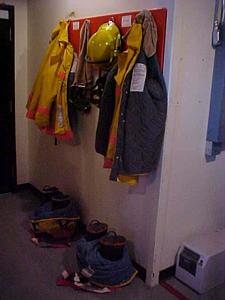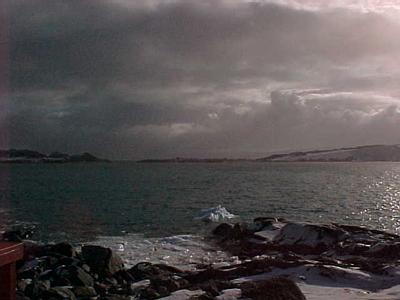31 March, 2000
Fire Drill
Question 41: What is the difference between the Celsius and Centigrade
temperature scales?
The station has to hold a minimum of one fire drill every month. Today was
the day for March! The risk of fire isn't as great here as at the south pole
where the air is much drier, but with our isolation it is still a concern.
With no fire station to call for help, we have to supply our own firefighters.
Several people on the station crew go through a week of fire-fighting
training at the Rocky Mountain Fire Academy in Colorado before coming down
here. During their training they practice using the SCBA (self-contained
breathing apparatus) units and handling fire hoses and extinguishers, learn
about how fires move and grow, and practice search and rescue techniques for
finding lost people in smoky buildings. They also are trained to respond to
hazardous material spills. The station has a fire suppression system in Bio
Lab and GWR that consists of a huge pressurized tank of water.
When an alarm goes off, the three or four station crew members designated as
first responders grab fire extinguishers and head for the source of the alarm
to check it out . Meanwhile, the four firefighters (two teams of two) and the
one backup firefighter are suiting up. They wear heavy boots, fire and heat
retardant pants and heavy coats just like firefighters everywhere. The face
mask seals to keep out smoke and is connected to the SCBA unit that is worn
with the valve down on the back. Each firefighter has two sets of gear, one
in GWR, one in Bio Lab so he/she can dress in whichever is nearest when the
alarm goes off.
Other members of the staff have designated tasks to perform during a fire.
The station manager is the fire marshal. He is in command at the scene,
sending in or pulling out SCBA teams, calling for the doctor, giving orders to
other personnel, and making all decisions. The maintenance technician stands
by the fire suppression tank and back-up generator in Bio Lab with a radio,
ready to pressurize the system on command from the fire marshal. Our work
order coordinator mans the muster station and makes sure all the people on the
station are accounted for. The communication technician relays information
and records what is done in the coms log.
The rest of us are responsible for mustering (exiting the building we are in
and assembling at the boathouse). If the fire is at the boathouse, we muster
in the GWR garage. When we arrive at the muster point we are accounted for
and are available to help those dealing directly with the fire in any way
needed. This is the main reason we have to sign out on the board when we
leave the immediate station area. In case of an emergency, we do not want the
firefighters to be risking themselves searching for someone who is away from
the station and not in the burning building. Since we are so far away from
advanced medical help, the primary aim of the firefighters is to keep the fire
from spreading any further, not necessarily to put it out. They would go into
a fully engaged fire only to look for missing people and get them out.
Today the drill had an added twist to it, a missing person. The fire marshal
had arranged that Chuck should "collapse" as if overcome by smoke in the
aquarium and not show up at the muster point. After he was identified as
missing, the fire team went in and conducted a search of the Bio Lab building.
This morning was still cold but sunny. By afternoon, the winds had changed
and a huge cloud front came in. Looking at the weather satellite images, we
see a series of storm systems coming in (see the 4/24 journal for more weather
information).
Answer 40: Since the Treaty was implemented in 1961, the Treaty nations have
adopted additions and protocols (working directions) to the basic Treaty. One
is the Convention for the Conservation of Marine Living Resources. It deals
with an ecosystem approach to managing fish and krill resources and sets up a
monitoring program. In 1991, the nations adopted an Environmental Protocol to
the Antarctic Treaty which requires environmental assessment of all proposed
human activity in Antarctica and prohibits oil, gas and other mineral
exploitation for 50 years. It also updated the protection of areas with
specific scientific importance. The Antarctic Treaty is very much a current
and active document.

Fire fighters' suits in the basement of Bio Lab.

SCBA backpack units and fire extinguishers.

Stormy weather coming.

Contact the TEA in the field at
.
If you cannot connect through your browser, copy the
TEA's e-mail address in the "To:" line of
your favorite e-mail package.
|
